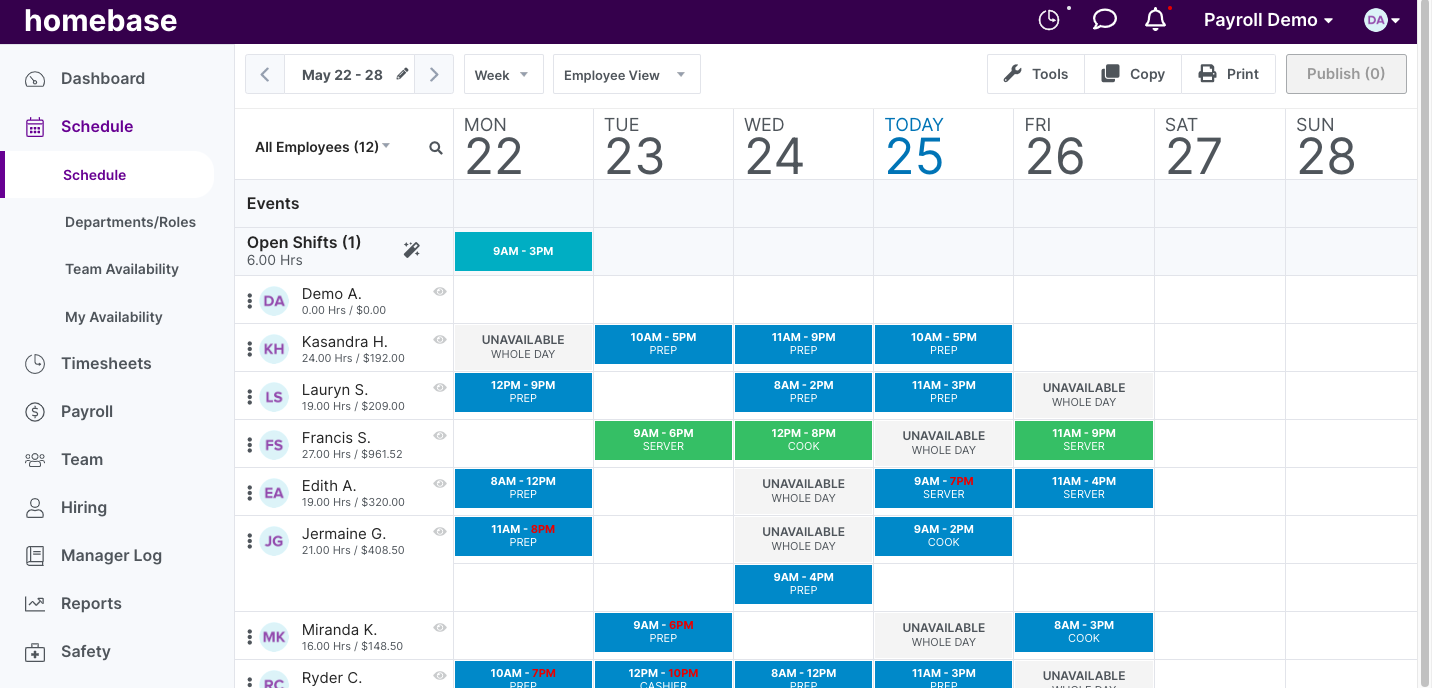In 2016, California approved a statute to increase the minimum wage yearly starting in 2017. This Senate Bill (SB) planned for the hourly rate to reach $15 in 2023, with inflation adjustments up to a maximum of 3.5%. This period has now passed and the California minimum wage rate is at $15.50.
However, the cost of living has also increased, and a $15.50 hourly rate doesn’t allow people to cover all of their expenses. According to a Zillow study, a person making minimum wage would need 2.7 full-time jobs to pay for a two-bedroom apartment in Los Angeles.
Offering accurate pay to your workers can help improve employee retention and satisfaction. But, salary increases also affect your business finances, especially if you have a small one. So, how do you ensure you’re paying living wages to your team while being profitable and following state regulations?
In this article, we’ll go through how much you need to pay your people according to county and city mandates. In addition, we’ll discuss how to remain compliant amid changes and how to pay your people fairly without reducing profit margins.
What is the California Minimum Wage?
Based on the 2016 SB 3, and inflation adjustments, California’s minimum wage is $15.50 per hour despite the business size. In the past, businesses with under 25 employees paid a lower hourly rate compared to larger businesses. Starting in 2023, all businesses are expected to pay the same minimum wage despite their size (with some exceptions).
Each county and city sets its own minimum wage limits and, up to this date, only Hayward businesses with less than 25 employees pay $15.50 per hour. All the other counties and cities have higher minimum rates.
Note: While $15.50 is the minimum hourly wage in California, the federal rate is still at $7.25 per hour. Plus, unlike in other states, California doesn’t allow employers to pay with tip credit, so there’s no tipped minimum wage in the Golden State. Check out this California employment law guide to ensure you’re complying with local regulations.
What’s the minimum wage in LA County?
The adjusted minimum wage rate for unincorporated areas of LA County is $16.90. You can check if your business is in Unincorporated LA County here.
However, the cities within LA County have different minimum wage rates. For example:
- Los Angeles City: $16.78
- Pasadena: $16.93
- West Hollywood: $19.08
Which California cities have a higher minimum wage?
As mentioned, minimum wage rates vary from city to city, so make sure you review the data for your specific locality (more on this below).
Here are the 5 cities in California with the highest minimum wage rate:
- Berkeley: $18.07
- San Francisco: $18.07
- Mountain View: $18.15
- Emeryville: $18.67
- West Hollywood: $19.08
California minimum wage summary
Here’s a quick look into what’ve covered so far:
- The hourly rate in California ranges from $15.50 to $19.08
- As of January 1st, 2023 all employers should pay the same minimum wage per locality despite the number of employees (with certain expectations)
- There’s no tip credit or tipped minimum wage in California, all employers need to pay the full amount
- West Hollywood is the highest paying city, for more information about specific city and county rates, refer to the chart below
| Locality | Effective date | Rate | Small employer rate (>25 workers) |
| Alameda | 7/1/2023 | $16.52 | |
| Belmont | 1/1/2023 | $16.75 | |
| Berkeley | 7/1/2023 | $18.07 | |
| Burlingame | 1/1/2023 | $16.47 | |
| Cupertino | 1/1/2023 | $17.20 | |
| Daly City | 1/1/2023 | $16.07 | |
| East Palo Alto | 1/1/2023 | $16.50 | |
| El Cerrito | 1/1/2023 | $17.35 | |
| Emeryville | 7/1/2023 | $18.67 | |
| Foster City | 1/1/2023 | $16.50 | |
| Fremont | 7/1/2023 | $16.80 | |
| Half Moon Bay | 1/1/2023 | $16.45 | |
| Hayward | 1/1/2023 | $16.34 | $15.50 |
| Los Altos | 1/1/2023 | $17.20 | |
| Los Angeles | 7/1/2023 | $16.78 | |
| Los Angeles County (unincorporated) | 7/1/2023 | $16.90 | |
| Malibu | 7/1/2023 | $16.90 | |
| Menlo Park | 1/1/2023 | $16.20 | |
| Milpitas | 7/1/2023 | $17.20 | |
| Mountain View | 1/1/2023 | $18.15 | |
| Novato | 1/1/2023 | $16.07* | $15.53 |
| Oakland | 1/1/2023 | $15.97 | |
| Palo Alto | 1/1/2023 | $17.25 | |
| Pasadena | 7/1/2023 | $16.93 | |
| Petaluma | 1/1/2023 | $17.06 | |
| Redwood City | 1/1/2023 | $17.00 | |
| Richmond | 1/1/2023 | $16.17 | |
| San Carlos | 1/1/2023 | $16.32 | |
| San Diego | 1/1/2023 | $16.30 | |
| San Francisco | 7/1/2023 | $18.07 | |
| San Jose | 1/1/2023 | $17.00 | |
| San Mateo | 1/1/2023 | $16.75 | |
| San Mateo County (unincorporated) | 4/1/2023 | $16.50 | |
| Santa Clara | 1/1/2023 | $17.20 | |
| Santa Monica | 7/1/2023 | $16.90 | |
| Santa Rosa | 1/1/2023 | $17.06 | |
| Sonoma | 1/1/2023 | $17.00 | $16.00 |
| South San Francisco | 1/1/2023 | $16.70 | |
| Sunnyvale | 1/1/2023 | $17.95 | |
| West Hollywood | 1/1/2023 | $19.08 |
*Very large business rate (100+ employees): $16.32
How can small business owners ensure they’re compliant with California state labor laws?
Staying compliant while being in charge and managing a small business isn’t an easy job. This is especially true when you’re also setting schedules, running payroll, calculating overtime payments, covering for others on sick leave, interviewing and hiring, and doing taxes.
Handling everything manually makes it easy to overlook a small but important aspect of your business or make calculation mistakes that leave you out of compliance with the law.
All in all, the best way to ensure you’re staying on top of regulations and are being compliant is by using an all-in-one HR and team management platform like Homebase.
This tool helps you create work charters, set up a clock-in and out system at your business, and pay accurately according to California 2023 labor laws — with little action from your side.
So, instead of manually creating schedules, Homebase can do it automatically for you. Or, instead of working late on a Friday manually entering the timesheet data into your payroll system, you can use Homebase’s time clock, and simply review and approve your team’s hours. You can also pay people directly from there without having to input the data into any other app — although you can connect Homebase to your preferred payroll system.
Homebase also calculates overtime, PTO, and taxes, and reminds employees in case their file is missing any information. It also gives you access to HR advisors who can help you review your policies and answer specific questions regarding local laws and regulations.

How can small businesses prepare for minimum wage increases?
With the National Customer Price Index (CPI) expected to reach 5.16% in April 2024, the minimum wage rate is likely to keep increasing in the next couple of years. Taking proactive steps to increase profit margins and preparing for future increases allows you to keep providing your employees with accurate pay without being highly impacted by it.
Here are ideas to implement in your business and get prepared for potential salary increases:
1. Audit your expenses
Review your monthly income and expenses to come up with a staffing plan that aligns with your possibilities and see if there are any costs you can cut. For example, you might benefit from hiring temporary employees for seasonal spikes rather than hiring full-time employees and letting them go after a couple of months. Check with your HR advisor to ensure you’re staying compliant.
Auditing your expenses also lets you identify if there are any unnecessary services, providers, or even employees you’re incurring. This audit should leave you with specific next steps to help you close those gaps.
2. Increase prices
Conducting financial audits allows you to determine whether or not you’re charging the right prices. In many cases, you might need to change your rates to get a bigger profit margin and have more wiggle room to give your employees a living wage.
You might need to plan for periodic price increases and notify your customers about your decision. Be sure to explain why you’ll be increasing your prices and mention that it’s because you want to continue offering accurate pay to your team.
3. Find more affordable providers
Higher prices aren’t the only way to increase your profit margins. The audit can also help you identify if you’re paying too much money to a particular provider.
Audit how much you pay for certain supplies and benchmark those prices. It’s possible that you might find a better option in the market that allows you to either negotiate rates or change vendors. Make sure you continue to offer the same level of service to your customers despite internal modifications.
4. Improve your hiring practices
Retaining employees is more affordable than hiring and training new ones. So, focus on improving your hiring practices: ask for recommendations, offer trial periods, and establish a training program to increase your chances of retaining them. Also, offering more than minimum wage can help you reduce your turnover rate and increase morale and engagement.
According to the latest data from the Bureau of Economics, an average person needs to earn $4.423,5 a year to live in California. Assuming that the 2021 number is still true, a minimum wage worker would need to work at least two full-time jobs to afford living expenses. If your employees can’t make a living with the salary that you pay them, they’re likely to be demotivated or look for other options. So, offering a living wage instead of a minimum wage can help you lower your turnover rates.
5. Budget for overtime or adjust business hours
In California, you need to pay extra hours if a person works more than eight hours in a day, more than 40 hours in a week, or does eight hours of work on the seventh consecutive day of the week. The excess hours are paid at one and one-half times the usual hourly wage.
If the person works more than 12 hours a day or more than eight hours on the seventh consecutive day, you have to pay them at least twice the regular rate for the additional work. Make sure you get expert advice to comply with California overtime laws.
Since overtime can be expensive, you should set a monthly budget aside to cover it. However, you can also audit your business hours and look into reducing open hours if there are times or days when your business isn’t busy. This allows you to reduce your payroll and reduce the need for extra hours.
6. Come up with promotions
Sometimes increasing prices, cutting costs, and retaining employees isn’t enough. There are times when you just need to sell more. Think creatively about how you can find more customers and increase your income without becoming overburdened.
For example, if you have a coffee shop, you can come up with a fidelity program. Every time a customer buys five coffees, they earn a cookie. Do the math and offer whatever makes sense for your business, but incentivizing your customers to become habitual and spend more will help you increase your profit margins.

7. Reduce your offering
You can also conduct an audit of your service or product offering and determine which are underperforming. Reducing your offering can help you cut unnecessary costs.
Let’s go back to the coffee shop example. Let’s say you discovered you’re frequently throwing away soy milk because it expires. Looking into it, you realize customers prefer oat milk and only 1 in 15 customers ask for soy milk. This information allows you to stop serving soy milk and save money.
8. Automate certain tasks with an all-in-one HR system
Audit your operations and determine if there are any tasks that can be performed by a system. Can you set up self-service checkout stations at your shop? Can you delegate payroll to an automated tool like Homebase? Can you streamline your people operations?
With an all-in-one HR system like Homebase, you can automate your operations without having to have multiple employees working on those tasks. For example, let’s say you have multiple branches of your coffee shop. Each location has a manager who’s in charge of scheduling, approving time off, reviewing and entering timesheets into the payroll system, notifying employees of announcements, and training new people. It’s a lot of manual work so they can’t handle more than one branch at a time.
Homebase allows you to delegate those tasks to the tool and reduces the need for dedicated branch managers. One could handle multiple locations from afar and only visit the branch for period checkups, special needs, or managing conflict.
Other than that, teams can clock in and out through their phones, you can communicate with them through the business chat, set automated schedules based on their availability, and pay them directly from the system. Plus, you don’t have to worry about compliance, because we help you guarantee you’re always on top of your local laws and regulations.

Complying with California minimum wage: What you need to know
Small businesses need to stay compliant with state laws, not only to provide fair pay but also to stay in business. As of 2023, the California minimum wage stands at $15.50 per hour, but the rates vary in cities and counties, so you need to review which applies to you.
It’s important to highlight that California no longer differentiates minimum wages based on business size (with some exceptions) and that it doesn’t allow for tip credit. So, in cities like West Hollywood, you need to pay the full hourly rate of $19.08.
It’s possible that minimum wage rates continue to change throughout the following years. So, you should take proactive steps to increase your profit margins and be able to afford your team’s salary. To do so, you should look into:
- Auditing your expenses, operations, and providers to identify potential cost-cutting opportunities
- Increasing prices with an adjusted profit margin
- Improve your hiring practices to recruit better, more lasting employees
- Automating your people operations and reducing headcount
Partnering with an all-in-one HR and team management system like Homebase empowers you to simplify workforce management. We help you stay compliant, give you access to HR experts, track your team’s time, and pay accurately. All with the minimum amount of manual work.
